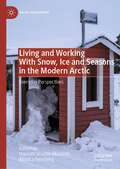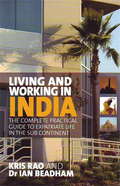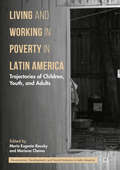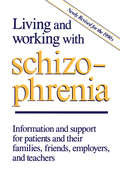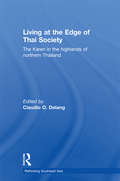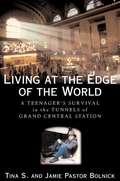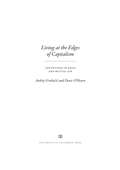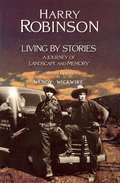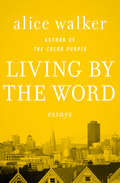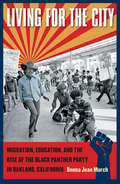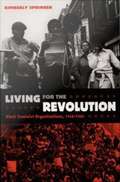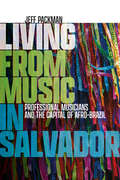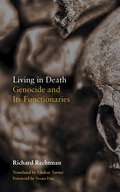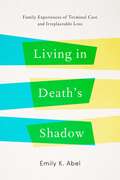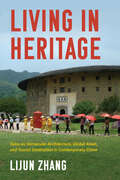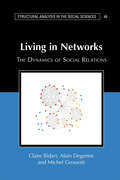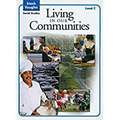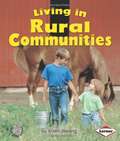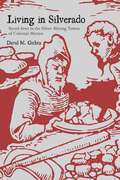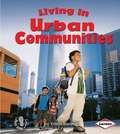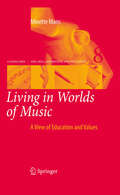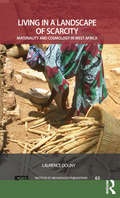- Table View
- List View
Living and Working Together: Neighborhoods Book 2
by Dahia ShabakaSocial Studies textbook for 2nd Grade
Living and Working Together: Neighborhoods Book 2 (Living And Working Together)
by Dahia ShabakaSocial Studies textbook for 2nd Grade
Living and Working With Snow, Ice and Seasons in the Modern Arctic: Everyday Perspectives (Arctic Encounters)
by Monica Tennberg Hannah Strauss-MazzulloThis book describes everyday practices of life in changing Arctic winter conditions. The authors explore the contemporary and situated outdoor practices in different work settings in Finnish Lapland and investigate how, for example, tourism, reindeer herding, cattle breeding and urban snow management adapt to the physically limiting or enabling features of cold temperatures, snow and ice. The book also highlights individual and societal adjustments to such harsh conditions and their seasonal changes in mobility, including winter cycling, use of snow mobiles and walking with studded shoes. The impact of a warming climate is a great concern for those utilising the enabling qualities of winter weather. The need, then, for continuous adaptation in everyday practices of work and mobility will increase in the future.
Living and Working in India: The Complete Practical Guide To Expatriate Life In The Sub Continent
by Kris RaoAs well as being a fascinating country, with a rich and varied culture, India is emerging as a major world economy. More and more people are going there to live and work. The purpose of this book is to ease the transition between western and Indian cultures. If you are going to India to do business or for long-term employment, or are being relocated there by your company, this book will tell you all you need to know to help you and your family settle quickly into your new environment - and to ensure that it is the experience of a lifetime.Beginning with an overview of the history of India, its geographical divisions, political system, religions, languages and ethnic and cultural divisions, this comprehensive guide goes on to provide detailed information on: how to get a work permit and find a job; Indian work practices, employment rights and benefits; taxes and pensions; the Indian health care system; how to set up a business and set up a company; how to buy or rent a property; what the cost of living is like; how to open a bank account and obtain a credit card; expatriate and Indian lifestyles; entertainment and leisure in India; Indian customs and habits food - the regional variations and local delicacies; and raising and educating your children.
Living and Working in India: The complete practical guide to expatriate life in the sub continent
by Kris RaoAs well as being a fascinating country, with a rich and varied culture, India is emerging as a major world economy. More and more people are going there to live and work. The purpose of this book is to ease the transition between western and Indian cultures. If you are going to India to do business or for long-term employment, or are being relocated there by your company, this book will tell you all you need to know to help you and your family settle quickly into your new environment - and to ensure that it is the experience of a lifetime.Beginning with an overview of the history of India, its geographical divisions, political system, religions, languages and ethnic and cultural divisions, this comprehensive guide goes on to provide detailed information on: how to get a work permit and find a job; Indian work practices, employment rights and benefits; taxes and pensions; the Indian health care system; how to set up a business and set up a company; how to buy or rent a property; what the cost of living is like; how to open a bank account and obtain a credit card; expatriate and Indian lifestyles; entertainment and leisure in India; Indian customs and habits food - the regional variations and local delicacies; and raising and educating your children.
Living and Working in Poverty in Latin America: Trajectories of Children, Youth, and Adults (Governance, Development, and Social Inclusion in Latin America)
by María Eugenia Rausky Mariana ChavesThis edited volume studies the complex interrelation of poverty, work, and different stages in the life course, and how it contributes to the permanent existence of poverty and inequality in vulnerable groups in society. Mechanisms of productions and reproduction of these relationships are identified through empirical research carried out in four Latin American countries: Mexico, Argentina, Brazil, and Cuba. This book centers on the experiences of individuals in those less favored social groups who may have suffered structural poverty for decades, or who may have been simply deprived of a basic income to cover their most essential needs.
Living and Working with Schizophrenia
by Joel J. JeffriesFor the families of schizophrenics, fear, guilt, frustration, and despair can become part of daily life. Several years ago the authors of this volume established a program at the Clarke Institute of Psychiatry in Toronto to help the families of schizophrenics cope with the sometimes debilitating emotions they typically experience. The first edition of Living and Working with Schizophrenia grew out of that program. Published to international acclaim in 1982, it offered practical advice and clear, accessible information to those who suffer from schizophrenia, their relatives, friends, teachers, and employers.This edition has been completely updated and includes entirely new sections and more case vignettes. The authors have expanded the information on family education, counseling, and social issues, addressing such topics as community organizations, adoption, pregnancy, parenting, and sexuality.From the medical perspective, the authors explore in detail diagnosis and prognosis and describe the drugs used in the treatment of schizophrenia, with information on their effects and side-effects. The latest research is taken into account, and all is explained in language readily understood by the lay reader.
Living at the Edge of Thai Society: The Karen in the Highlands of Northern Thailand (Rethinking Southeast Asia)
by Claudio DelangThe Karen are one of the major ethnic minority groups in the Himalayan highlands, living predominantly in the border area between Thailand and Burma. As the largest ethnic minority in Thailand, they have often been in conflict with the Thai majority. This book is the first major ethnographic and anthropological study of the Karen for over a decade and looks at such key issues as history, ethnic identity, religious change, the impact of government intervention, education land management and gender relations.
Living at the Edge of the World
by Tina S. Jamie Pastor BolnickWhen Tina S. meets April, a teenage runaway, she thinks she's found her best friend. She leaves behind her dysfunctional family to join April in the tunnels of Grand Central Station amidst the homeless and drug addicted. Soon she's bingeing on crack--just like April--and stealing, scamming and panhandling to support her habit and to survive on the streets. In her own words, she describes her descent into crack addiction, being raped in the tunnels, her several arrests and jail terms and her grief and guilt over the death of April, whom she'd come to love. Finally faced with the reality that she might not make it through one more day, Tina takes her first difficult steps towards a normal life.With the help of a homeless advocate and his wife, a gay uncle dying of AIDS, and the woman who was to become her co-author on this book, Tina turns her life around and makes her way back to the world of the living.
Living at the Edges of Capitalism
by Andrej Grubacic Denis O'HearnSince the earliest development of states, groups of people escaped or were exiled. As capitalism developed, people tried to escape capitalist constraints connected with state control. This powerful book gives voice to three communities living at the edges of capitalism: Cossacks on the Don River in Russia; Zapatistas in Chiapas, Mexico; and prisoners in long-term isolation since the 1970s. Inspired by their experiences visiting Cossacks, living with the Zapatistas, and developing connections and relationships with prisoners and ex-prisoners, Andrej Grubacic and Denis O'Hearn present a uniquely sweeping, historical, and systematic study of exilic communities engaged in mutual aid. Following the tradition of Peter Kropotkin, Pierre Clastres, James Scott, Fernand Braudel and Imanuel Wallerstein, this study examines the full historical and contemporary possibilities for establishing self-governing communities at the edges of the capitalist world-system, considering the historical forces that often militate against those who try to practice mutual aid in the face of state power and capitalist incursion.
Living by Stories
by Harry Robinson Wendy WickwireLiving by Stories includes a number of classic stories set in the "mythological age" about the trickster/transformer, Coyote, and his efforts to rid the world of bad people - spatla or "monsters," but this volume also presents historical narratives set in the more recent past, which involve the arrival of new quasi-monsters - "SHAmas" (Whites).
Living by the Word: Essays
by Alice WalkerEssays from the Pulitzer Prize–winning author of The Color Purple—&“Vintage Alice Walker: passionate, political, personal, and poetic&” (Los Angeles Times). In a follow-up to her collection of essays, In Search of Our Mothers&’ Gardens, Walker takes a look at a vast range of issues both personal and global, from her experience with the filming of The Color Purple, to the history of African-American narrative traditions, to global threats of pollution and nuclear war. Walker travels broadly and maintains an eye for detail, resulting in a captivating journey of conscience by one of the most distinctive political and artistic voices in America. Readers will find inspiration and insights in even the briefest entries of this enthralling anthology. This ebook features an illustrated biography of Alice Walker including rare photos from the author&’s personal collection.
Living for the City: Migration, Education, and the Rise of the Black Panther Party in Oakland, California
by Donna Jean MurchIn this nuanced and groundbreaking history, Donna Murch argues that the Black Panther Party (BPP) started with a study group. Drawing on oral history and untapped archival sources, she explains how a relatively small city with a recent history of African American settlement produced such compelling and influential forms of Black Power politics. During an era of expansion and political struggle in California's system of public higher education, black southern migrants formed the BPP. In the early 1960s, attending Merritt College and other public universities radicalized Huey Newton, Bobby Seale, and many of the young people who joined the Panthers' rank and file. In the face of social crisis and police violence, the most disfranchised sectors of the East Bay's African American community--young, poor, and migrant--challenged the legitimacy of state authorities and of an older generation of black leadership. By excavating this hidden history,Living for the Citybroadens the scholarship of the Black Power movement by documenting the contributions of black students and youth who created new forms of organization, grassroots mobilization, and political literacy.
Living for the Revolution: Black Feminist Organizations, 1968-1980
by Kimberly SpringerThe first in-depth analysis of the black feminist movement, Living for the Revolution fills in a crucial but overlooked chapter in African American, women's, and social movement history. Through original oral history interviews with key activists and analysis of previously unexamined organizational records, Kimberly Springer traces the emergence, life, and decline of several black feminist organizations: the Third World Women's Alliance, Black Women Organized for Action, the National Black Feminist Organization, the National Alliance of Black Feminists, and the Combahee River Collective. The first of these to form was founded in 1968; all five were defunct by 1980. Springer demonstrates that these organizations led the way in articulating an activist vision formed by the intersections of race, gender, class, and sexuality. The organizations that Springer examines were the first to explicitly use feminist theory to further the work of previous black women's organizations. As she describes, they emerged in response to marginalization in the civil rights and women's movements, stereotyping in popular culture, and misrepresentation in public policy. Springer compares the organizations' ideologies, goals, activities, memberships, leadership styles, finances, and communication strategies. Reflecting on the conflicts, lack of resources, and burnout that led to the demise of these groups, she considers the future of black feminist organizing, particularly at the national level. Living for the Revolution is an essential reference: it provides the history of a movement that influenced black feminist theory and civil rights activism for decades to come.
Living from Music in Salvador: Professional Musicians and the Capital of Afro-Brazil (Music / Culture)
by Jeff PackmanLiving from Music in Salvador is an examination of music as labor, and musicians as laborers, in Salvador da Bahia, an urban state capital widely regarded as Brazil's most African city. Drawing on fieldwork that spans sixteen years, the book explores local musicians' lives and labors as members of a flexible work force in a setting that is culturally rich but economically poor. Often hidden in plain sight, these musician-workers are crucial participants in the economy of a city of nearly three million people that relies heavily on the commodification of Afro-diasporic expressive culture. Performing in clubs and restaurants, during Carnaval parades and festival celebrations, and on concert stages and recordings (at times backing marquee artists), they support themselves and their families and also serve as public representatives of Bahian culture to residents and tourists alike. Yet such audibility and the wages they earn from it are contingent on their ability to navigate complex and often contradictory industry and societal conditions that are profoundly informed by the entrenched legacies of colonization, the African slave trade, and the plantation system.
Living in Death: Genocide and Its Functionaries (Thinking from Elsewhere)
by Richard RechtmanWinner, Prix Littéraire Paris-Liège 2021 Winner, French Voices Award for Excellence in Publication and TranslationWhen we speak of mass killers, we may speak of radicalized ideologues, mediocrities who only obey orders, or bloodthirsty monsters. Who are these men who kill on a mass scale? What is their consciousness? Do they not feel horror or compassion?Richard Rechtman’s Living in Death offers new answers to a question that has haunted us at least since the Holocaust. For Rechtman, it is not ideologies that kill, but people. This book descends into the ordinary life of people who execute hundreds every day, the same way others go to the office. Bringing philosophical sophistication to the ordinary, the book constitutes an anthropology of mass killers.Turning away from existing psychological and philosophical accounts of genocide’s perpetrators, Rechtman instead explores the conditions under which administering death becomes a job like any other. Considering Cambodia, Rwanda, and other mass killings, Living in Death draws on a vast array of archival research, psychological theory, and anecdotes from the author’s clinical work with refugees and former participants in genocide. Rechtman mounts a compelling case for reframing and refocusing our attempts to explain—and preempt—acts of mass torture, rape, killing, and extermination.What we must see, Rechtman argues, is that for genocidaires (those who carry out acts that are or approach genocide), there is nothing extraordinary, unusual, or world-historical about their actions. On the contrary, they are preoccupied with the same mundane things that characterize any other job: interactions with colleagues, living conditions, a drink and a laugh at the end of the day. To understand this is to understand how things came to be the way they are—and how they might be different.
Living in Death’s Shadow: Family Experiences of Terminal Care and Irreplaceable Loss
by Emily K. AbelChallenging assumptions about caregiving for those dying of chronic illness.What is it like to live with—and love—someone whose death, while delayed, is nevertheless foretold? In Living in Death’s Shadow, Emily K. Abel, an expert on the history of death and dying, examines memoirs written between 1965 and 2014 by family members of people who died from chronic disease. In earlier eras, death generally occurred quickly from acute illnesses, but as chronic disease became the major cause of mortality, many people continued to live with terminal diagnoses for months and even years. Illuminating the excruciatingly painful experience of coping with a family member’s extended fatal illness, Abel analyzes the political, personal, cultural, and medical dimensions of these struggles.The book focuses on three significant developments that transformed the experiences of those dying and their intimates: the passage of Medicare and Medicaid, the growing use of high-tech treatments at the end of life, and the rise of a movement to humanize the care of dying people. It questions the exalted value placed on acceptance of mortality as well as the notion that it is always better to die at home than in an institution. Ultimately, Living in Death’s Shadow emphasizes the need to shift attention from the drama of death to the entire course of a serious chronic disease. The chapters follow a common narrative of life-threatening disease: learning the diagnosis; deciding whether to enroll in a clinical trial; acknowledging or struggling against the limits of medicine; receiving care at home and in a hospital or nursing home; and obtaining palliative and hospice care. Living in Death’s Shadow is essential reading for everyone seeking to understand what it means to live with someone suffering from a chronic, fatal condition, including cancer, AIDS, Alzheimer’s, and heart disease.
Living in Heritage: Tulou as Vernacular Architecture, Global Asset, and Tourist Destination in Contemporary China (Material Vernaculars)
by Lijun ZhangYongding County in southeast China is famous for its large, multistory communal vernacular buildings known as tulou, translated "rammed earth building." These structures were designated a UNESCO World Heritage Site in 2008. Living in Heritage introduces readers outside of China to this classic example of local Chinese architecture in the context of contemporary heritage preservation and tourism.Focusing on the Yongding Hakka Tulou Folk Culture Village, which is part of Hongkeng Village, author Lijun Zhang examines the on-the-ground processes and effects of heritage-making, UNESCO-inspired tourism, and how locals negotiate the dramatic transformation of their daily, social, and economic lives. Within an age of cultural change beginning at the start of the 21st century, Living in Heritage explores how the tulou phenomenon as heritage has and continues to be transformed into cultural, economic, or political capital. Through her careful study, Zhang reveals how the blurring of formerly distinct domains—private and public, local and global—gives rise to a living museum that now relies on insiders and outsiders to preserve their way of life.Living in Heritage offers an in-depth ethnographic account of the people dwelling and working within traditional tulou architecture in the 21st century.
Living in Networks: The Dynamics of Social Relations (Structural Analysis in the Social Sciences #49)
by Claire Bidart Alain Degenne Michel GrossettiHow do personal networks emerge from social contexts? How do these evolve during the course of a lifetime? How are relationships established, maintained, connected, disrupted? How does the structure of a network evolve as people face transitions and events? Based on a classic text originally published in France and that has become the standard on the empirical study of social networks there, for the first time, a network analysis perspective is extended from contexts and social circles to relationships and life events through empirical studies. Following in the tradition of personal network studies, this contribution to the field of structural analysis in Sociology offers both a synthesis of knowledge and original results from two immense surveys carried out in France. This volume proposes an original theory grounded in relational dynamics, offering novel perspectives on individual social relations over the course of a lifetime through the context of personal networks, access to social resources, and inequalities.
Living in Our Communities
by Steck-VaughnStudies the different communities of our country: Small communities, suburban communities, cities and teaches students how they can live in a community among each other.
Living in Rural Communities
by Kristin SterlingAn introduction to the common characteristics of a rural community.
Living in Silverado: Secret Jews in the Silver Mining Towns of Colonial Mexico
by David M. GitlitzIn this thoroughly researched work, David M. Gitlitz traces the lives and fortunes of three clusters of sixteenth-century crypto-Jews in Mexico&’s silver mining towns. Previous studies of sixteenth-century Mexican crypto-Jews focus on the merchant community centered in Mexico City, but here Gitlitz looks beyond Mexico&’s major population center to explore how clandestine religious communities were established in the reales, the hinterland mining camps, and how they differed from those of the capital in their struggles to retain their Jewish identity in a world dominated economically by silver and religiously by the Catholic Church.In Living in Silverado Gitlitz paints an unusually vivid portrait of the lives of Mexico&’s early settlers. Unlike traditional scholarship that has focused mainly on macro issues of the silver boom, Gitlitz closely analyzes the complex workings of the haciendas that mined and refined silver, and in doing so he provides a wonderfully detailed sense of the daily experiences of Mexico&’s early secret Jews.
Living in Urban Communities (First Step Nonfiction)
by Kristin SterlingAn introduction to the common characteristics of a urban community.
Living in Worlds of Music
by Minette MansInformed by her in-depth ethnomusical knowledge, the result of detailed fieldwork, Mans's book is about musical worlds and how we as people inhabit them. The book asserts that an understanding of our musical worlds can be a transformative educational tool that could have a significant role to play in multicultural music and arts education. She explores the way in which musical expression, with its myriad cultural variations, reveals much about identity and cultural norms, and shows how particular musical sounds are aesthetically related to these norms. The author goes further to suggest that similar systems can be detected across cultures, while each world remains colored by a distinctive soundscape. Mans also looks at the way each cultural soundscape is a symbolic manifestation of a society's collective cognition, sorting musical behavior and sounds into clusters and patterns that fulfill each society's requirements. She probes the fact that in today's globalized and mobile world, as people move from one society to another, cross-cultural acts and hybrids result in a number of new aesthetics. Finally, in addition to three personal narratives by musicians from different continents, the author has invited scholars from diverse specializations and locations to comment on different sections of the book, opening up a critical dialogue with voices from different parts of the globe. Musical categorization, identity, values, aesthetic evaluation, creativity, curriculum, assessment and teacher education are some of the issues tackled in this manner.
Living in a Landscape of Scarcity: Materiality and Cosmology in West Africa (UCL Institute of Archaeology Publications #63)
by Laurence DounyIn her close ethnography of a Dogon village of Mali, Laurence Douny shows how a microcosmology develops from people's embodied daily and ritual practice in a landscape of scarcity. Viewed through the lens of containment practice, she describes how they cope with the shortage of material items central to their lives—water, earth, and millet. Douny’s study is an important addition to ecological anthropology, to the study of West African cultures, to the understanding of material culture, and to anthropological theory.

